4.1 SOUND
Sound is a form of energy which emitted by a vibrating body that travels in the form of waves and causes the sensation of hearing. Sound cannot travel through vacuum.
4.2 PRODUCTION OF SOUND
We hear many sounds every day such as the sound of our school bell, an alarm clock, a barking dog and so on. We talk and communicate with others by producing sounds.
Sound is produced when a body vibrates (moves back and forth rapidly). In other words, sound is produced by vibrating bodies.
Note: Vibrations of the bodies produces sound so vibrations are the causes of sound.
Examples
• When a table is beaten, it starts vibrating and produces sound.
• When a drum is beaten, it starts vibrating and produces sound.
• When a stretched rubber band is struck, it starts vibrating and produces sound.
Musical instruments produce different types of sound because of vibration. For example; a flute produce sound because of vibration in its air column, a guitar produces sound because of vibration of its string, a drum produces sound because of vibration of its diaphragm.
Sound Produced by humans
A human being produces sound because of vibration of his voice box. The voice box is also known as larynx. Larynx is situated at the upper end of windpipe. There are two stretched membranes attached in larynx; with a narrow slit between them. When air passes through those stretched membranes they produce different types of sound with different combinations of stretching.
4.3 HOW IS SOUND TRAVELLED
Sound travels in the form of wave. When a pebble is dropped in pond water, it produces ripples in water. The ripple is called wave. Sound travels producing similar waves.
Wave motion where the energy or disturbance is transferred from one point to another in a medium, without the transfer of particles of the medium.
Terms related to wave motion
Amplitude (A)
The maximum displacement of the particles of a medium from their mean positions during the propagation of a wave is called amplitude of the wave. It is represented by the letter ‘A’.
Example:
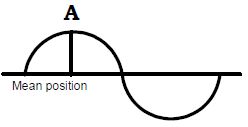
Here A is the amplitude of the wave.
Unit : The S.I unit of amplitude is metre (m).
Note: The amplitude of a wave is a measure of its energy. Thus the greater the amplitude of a wave, the greater the energy carried by the wave.
Time period (T)
The time in which a vibrating body completes one vibration is called time period or The time required to produce one complete wave (or cycle) is called time period of the wave.
Example: Suppose two waves are produced in 1 second. Then the time required to produce one wave will be 1/2 second or 0.5 second. In other words, the time period of this wave will be 0.5 second.
Note: The S.I unit of time period is second (s).
Frequency ()
The number of complete waves (or cycles) produced in one second is called frequency of wave or The number of vibrations per second is called frequency.
Unit: The S.I unit of frequency is hertz (which is written as Hz).
Hertz: When a vibrating body produces one vibration in one second, then its frequency is said to be one hertz.
1 hertz is equal to 1 vibration per second.
i.e. 1 hertz = ,
1 kHz = 1000 Hz
Relation between frequency and time period
The frequency of a wave is the reciprocal of its time–period.
i.e., frequency =
Where f = frequency of the wave and T = time period of the wave.
Wave length ()
Wavelength of a wave is the length of one wave.
The distance travelled by the wave in one time period is called the wavelength or The distance between two nearest particles which are in the same phase is called wave length. It is denoted by the Greek letter (lambda).
Example:
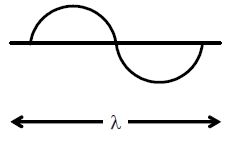
Unit : The S.I unit of wave length is meter (m).
Phase
The points on a wave which are in the same state of vibration are said to be in the same phase.

In the above figure A, B are in the same phase and C, D are in the same phase.
Example: All points that lie on the crests are in the same phase similarly all points that lie on the trough are in the same phase.
Wave Velocity (V)
It is the distance travelled by a wave in one second.
Note:
The wave velocity is different from the velocity of the particle in the wave. The velocity of wave in a medium is constant, whereas the velocity of an oscillating particle changes continuously.
The velocity of oscillating particle is zero at extreme positions and maximum at mean positions.
Expression for wave velocity
We know that, velocity of the wave =
Suppose a wave travels a distance in time T, then
[i.e. the relation between wave velocity, wavelength and time period]
Hence T is the time taken by one wave. We know that becomes the number of waves per second and this is known as frequency (f) of the wave.
So the above equation can also be written as, v = f ×
Where, v = velocity of the wave ; f = frequency; = wavelength
In other words velocity of a wave = frequency × wavelength
Thus, the velocity (or speed) of a wave in a medium is equal to the product of its frequency and wavelength. The formula v = f × is called wave equation.
Types of waves
On the basis of the relative directions of the propagation of the wave with respect to direction of the periodic changes in the medium (such as displacement, pressure etc.) the waves are classified into (i) Longitudinal waves and Transverse waves
Longitudinal wave
A wave in which the particles of the medium oscillate (vibrate) to-and-fro (back and forth) in the same direction in which the wave is moving, is called a longitudinal wave. (OR)
A wave in which the particle of the medium vibrate up and parallel to the direction of wave is longitudinal wave.
Example
1. Sound waves in air
2. Waves in spiral spring
3. The waves produced in air when a sitar wire is plucked.
Transverse wave
A wave in which the particles of the medium oscillate (vibrate) up and down, i.e perpendicular to the direction in which the wave is moving is called a transverse wave.
(or) If the particles of the medium vibrate perpendicular to the direction of the propagation of the wave then the wave is called transverse wave (or) When the particles of a medium oscillate at right angles to the direction of propagation of a wave, then the wave so produced is called a transverse wave.
Examples :
1. Waves on the surface of water
2. Waves on a long stretched rubber tube
3. Waves along a stretched string.
4. Even the light waves and radio waves are transverse waves.
4.4 PROPAGATION OF SOUND IN DIFFERENT MEDIA
The substance through which sound travels is called a medium. The medium can be a solid substance, a liquid or a gas. Solids, liquids and gases are called material media. Sound needs a material medium like solid, liquid or gas to travel. In other words, sound can travel through solids, liquids and gases but it cannot travel through vacuum (or empty space). Sound waves are called mechanical waves because they need a material medium (like solid, liquid or gas) for their propagation.
Note: Sound travels about 15 times faster in steel than in air.
4.5 PERCEPTION OF SOUND
Sound is perceived by the vibration of the ear drum (Tympanic memberane). Sound moves in air into the form of longitudinal waves. The vibrating particles of the longitudinal wave make the ear drum to vibrate at the same frequency as the source. This causes the effect of hearing sounds.
Note: We can perceive the direction of sound with a certain accuracy. left and right location of sound is determined by the perception of difference in the arrival time at each ear. A give sound reaches at one ear first and then at the second ear after a certain time interval. based on this time interval, we can identify the direction of the sound.
Scuba divers ( divers under sea) find it difficult to ascertain the direction from which an under water sound is coming, because the sound waves are moving so quickly in water that they reach both the ears at the same time.
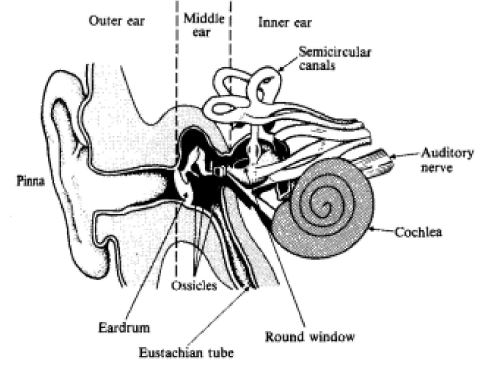
Persistence of hearing
The impact of sound should remain on the eardrum for a minimum interval to perceive the sound clearly. This minimum time interval is known as persistence of hearing. For the human ear, the persistence of hearing is equal to th of a second. If two sound fall on the eardrum within th of a second, they cannot be differentiated.
4.6 AUDIBLE AND INAUDIBLE SOUNDS
We cannot sense the sounds produced by all vibrating bodies. For example, we cannot sense the sound produced by a vibrating pendulum. This is because the frequency of the pendulum is very less. We will be able to sense the sounds having frequencies from 20Hzt 20,000H
Based on frequency, waves can be classified as:
i. Audible range
ii. Infrasonic
iii. Ultrasonics
Audible range
The range of frequencies that people with normal hearing can detect is called the audible range.
The highest frequency that humans can hear is the upper limit of your hearing. For young people this is usually between 16000 and 20,000 Hertz. There is also a lower limit. This is about 20 Hertz.
Thus, “the hearing range or the range of human audibility is 20 Hz to 20,000 Hz”.
Infrasonic Sound
Some vibrations produce sounds below the normal hearing range. These are known as infrasonic sounds (below 20Hz). Earthquakes, underground nuclear explosions, and tides, all produce infrasonic sounds. These sounds, although they cannot be heard by humans, can be detected by a device called a seismometer.
Ultrasonic Sound
Vibrations above the normal hearing range produce ultrasonic sounds (above 20,000 Hz).
Many animals like bats, dolphins, dogs, produce and hear such sounds. For example, humans can hear only part of the high-pitched squeak of the mouse. The mouse squeak is also made up to ultrasonic sounds which can be heard by a hunting cat.
Many forms of animal life depend on ultrasonic sound for their survival.
Application
1. Investigation of Structure of Matter
Sending ultrasound through bulk of matter and studying the variation in their velocity inside it, valuable information regarding the constitution of complex molecules can be obtained.
2. Cleaning
Dirty odd shaped parts, spiral tubes, electronic components are placed in a cleaning solution and ultrasonic waves are passed through it. Due to high frequency vibrations particles of dirt get detached and drop out. The
objects are thoroughly cleaned.
3. Detection of flaws (Cracks) in Metals
Ultrasound is sent through the metallic structure. They pass through unobstructed structure if the structure is homogeneous. In case of a crack inside the structure the ultrasound will be reflected back towards observer and received. Existence of reflection, confirms existence of a crack. Due to high frequency and short wavelength, even fine cracks can be detected.
4. Depth of Seas and Oceans
Ultrasound oscillator producing waves of frequency 40 kHz is provided inside ships. An ultrasound receiver is also provided inside the ship.
The transmitter oscillator transmits the waves towards bottom and reflected waves are received by the receiver.
A recorder finds the time interval (t). Knowing velocity (v) of ultrasound through sea water, the depth (d) can be calculated as .
A similar mini arrangement can be used for finding the depth of liquid level in a tank without opening its cover.
5. Sound Ranging
A special equipment called Sonar is used for this purpose.
6. Emulsions of Immiscible Liquids
When a strong beam of ultrasound is passed through a liquid, it is heated to a very high temperature. This fact is utilized in preparing homogeneous stable emulsion of immiscible liquids. Ultrasound treated honey does not crystallize.
7. Medical and Biological Effects
a. When ultrasound is passed through a body part having muscular pain or rigid joints, their high frequency vibrations produce soothing effect and relieve the pain.
b. Ultrasound sent through brain cures a mental patient.
c. A newly developed technique of three dimensional photographs with the help of ultrasound (ultrasonography) is being used by the physicians to locate the exact position of an eye tumor and its removal giving normal vision to the patient.
d. Harmful insects are killed by exposing them to ultrasound.
4.7 REFLECTION OF SOUND
When a wave going from one medium comes back to the same medium after striking the second medium, reflection of the wave is said to take place. Sound wave also suffer reflection like light waves. The reflection of sound can be demonstration as follows:
Take a drawing board and fix it on the floor. Put two metallic or cardboard tubes. These tubes are making some angle with each other. Put a clock near the end of one tube and a screen between the two tubes so that sound of clock may not be heard directly by the ear placed in front of the second tube. The second (like tick-tick) waves pass through the tube are reflected by the drawing board.
The reflected sound waves enter the second tube and are heard by the ear placed in front of the second tube.
Go on adjusting the position of the second tube. A stage will come when the loudness of the sound heard through the second tube is maximum. At this stage, the incident angle i = reflected angle r , which is the law of reflection.
Applications of Reflection of Sound
1. Megaphone
Megaphone is a device used to address public meetings. It is horn-shaped. When we speak through megaphone, sound waves are reflected by the megaphone. These reflected sound waves are directed towards the people without much spreading.
2. Hearing Aid
Hearing aid is used by a person who is hard of hearing. The sound waves falling on hearing aid are concentrated into a narrow beam by reflection. This narrow beam of sound waves is made to fall on the diaphragm of the ear.
Thus, diaphragm of the ear vibrates with large amplitude. Hence, the hearing power of the person is improved.
3. Sound Boards
Sound boards are curved surfaces (concave) which are used in big hall to direct the sound waves towards the people sitting in a hall. The speaker is placed at the focus of the sound board.
Sound waves from the speaker are reflected by the sound board and these reflected waves are directed towards the people.
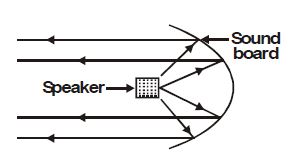
4.8 ECHO
It is a common experience that when we shout in front of a high mountain or a deep valley or a deep wall or in a big empty hall, we hear our sound back after a few seconds. This is known as echo. An echo is simply a reflected sound.
Thus, the sound heard after reflection from a rigid obstacle is called an echo. (or)
The repetition of sound caused by the reflection of sound waves is called an echo.
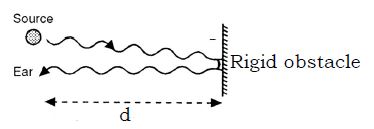
Minimum distance of hear an echo
The human ear can hear two sounds separately only if they reach the ear after an interval of 1/10th of a second. This is a natural feature of the human ear. If we take the speed of sound roughly as 340 m/s, the distance travelled by sound in 1/10th of a second would be 34 m. This means that we are able to hear the original and the reflected sound if we are at a distance of 17 m or more from the reflecting surface. This results in hearing the reflected wave known as echo.
Calculation of minimum distance to hear an echo
We know that:
Speed of sound = 340 m/s (in air)
Time taken = s (persistence of hearing)
(time gap between the original sound and its echo) Distance travelled = ?
Now, putting these values in the above formula, we get:
Distance travelled =
Thus, the distance travelled by sound in going from us (the source of sound) to the sound reflecting surface (wall), and then coming back to us should be 34 metres. So our distance from the sound reflecting surface (like a wall, etc,) to hear an echo should be half of 34 metres which is 34/2 = 17 metres. From this, we conclude that the minimum distance from a sound reflecting surface (like wall, etc) to hear an echo is 17 metres.
Relation between speed of sound, time of hearing echo and distance from reflecting body.
If t is the time in which an echo is heard, d is the distance between the source of sound and the reflecting body, and v is the speed of sound, then the total distance travelled by the sound is 2d.
S = Source of soundd = Distance between source of sound and reflecting body.
O = Observer
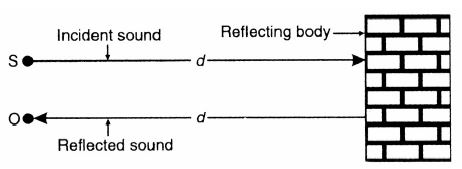
In the time t seconds. distance travelled by sound = 2d
Hence, in time 1 seconds. distance travelled by sound
But, distance travelled by sound in 1 second. = Speed of sound
Condition for the formation of an echo
The minimum distance between the source of sound and the reflecting body should be 17 meters.
Reverberation
If a sound is made in a big hall, the sound waves are reflected from the walls, ceiling and floor of the hall, and produce many echoes. The echo time however, so short that the many echoes overlap with the original sound. Due to this original sound seems to be prolonged and lasts for a longer time. In other words, a sound made in a big hall persists (on lasts) for a longer time.
The repeated multiple reflection of sound in any big enclosed space is called reverberation.
(or)
The persistence of sound in a big hall due to repeated reflection from the walls ceiling and floor of the hall is called reverberation. Thunder that follows lightning flash during a storm is an excellent example of reverberatory or multiple echoes. Reverberations are also produced in a closed room.
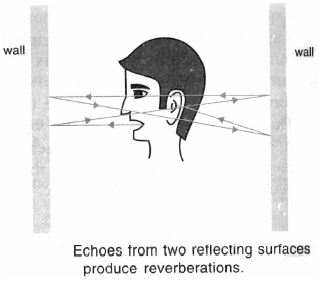
Note: To reduce the reverberation to almost zero level, the walls and the ceiling of the hall are covered with sound absorbing materials, such as rough plaster, fibre board or loose woolen or cotton cloth.
Sonar
Another application of reflection of sound in Sound Navigation and Ranging (SONAR). The process of locating the position of objects submerged in water e.g., submarines and icebergs, by the reflection of sound from them is called echo depth sounding. It is also used for finding the depth of the sea. The instrument used for this purpose is called SONAR.
A sonar consists of a transmitter and a receiver. The transmitter is the source of ultrasonics. With the help of crystals that can be made to vibrate electrically, ultrasonics of frequency up to 1000 MHz can be produced.
The ultrasonic waves from the transmitter travel under water in all directions. When they strike an object they are reflected. The receiver receives the reflected ultrasonic waves from the object. It records not only the reflected waves but also the time ‘t’ taken by them to travel from the ship and back from the object.
Knowing the speed ‘v’ of sound waves in water , the depth of the object is found using the relation, .
The sonar not only indicates the distance of the object, but also its approximate direction.
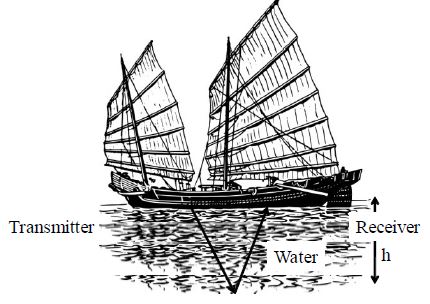
4.9 CHARACTERISTICS OF SOUND
We here different types of sound around us. Some sounds are pleasant to our ears, whereas some unpleasant.
Musical Sound
Musical sound is produced by periodic vibrations. It has regular wave forms. Musical sound is produced by musical instruments like sitar, violin and drum. It produces a pleasant effect on the ear. Musical sound is one which produces pleasing sensation.
Thus, sounds which are pleasing to the ears are called music.
Noise
Noise is produced by non-periodic vibrations. It has irregular wave forms. Noise is produced by machines in a factory, moving train by the traffic at a busy crossing, horns by trucks and buses are the example of noise. It produces an unpleasant effect on the ear.
DIFFERENCE BETWEEN MUSICAL SOUND AND NOISE
|
Musical sound |
Noise |
|
1. It has a pleasa nt effect on the ears 2. Made by regular and periodic vibrations
3. Has a definite frequency 4. It is produc ed by musical instruments 5. Has an regular wave form 6. Can be reproduced |
1. It has un-pleasa nt effect on the ear 2. Made by irregular and non- per iodic vibrations 3. Does not have a definite fr equency 4. It is produced by machi nes in a factory moving buses, cars and tra ins etc., 5. Has an irregular wave form 6. Cannot be reproduced |
Wave representation

Characteristics of musical sounds
The three characteristics of musical sounds by which they can be distinguished from one another one as follows.
1. Loudness or intensity
2. Pitch or shrillness and
3. Quality or timbre
Loudness or Intensity
Loudness: Loudness is the property of sound which distinguishes the degree of sensation produced in the ear.
It is a characteristic of both musical sound and noise loudness depend on the intensity of sound.
The amount of sound energy passing each second through a unit area, is called intensity of sound.
It is our common experience that when we shout, we use more energy and hence produce a louder sound. Similarly, when we whisper, we use less energy and hence produce a lower sound.
Loudness is the characteristic of a musical sound by which a loud sound can be distinguished from a faint sound even though both have the same pitch.
Factors effecting the loudness of sound
1. Amplitude of vibration of the sources
It has been found that greater the amplitude of vibration of the source, the greater is the intensity (and hence loudness) of sound and vice versa. It we strike a drum softly its skin vibrates with a smaller amplitude and a soft sound is produced. If we strike the same drum harder, its skin vibrates with a greater amplitude and a louder sound is produced. This shows that greater the amplitude, the louder is the sound.
Mathematically and experimentally, loudness of sound is directly proportional to the square of the amplitude of the wave.
i.e loudness (on intensity ) (amplitude)2

2. Surface area of the vibrating body
The greater the surface area of the vibrating body, the greater is the loudness of sound.
A large drum (having larger surface area) will produce a louder sound than a small drum (having smaller surface area)
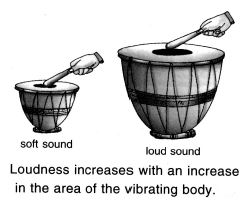
3. Distance from the vibrating body
Loudness depends on the distance between the listener and the source. The lesser the distance between the listener and the source, the louder is the sound heard by the listener and vice versa. The loudness of sound varies inversely as the square of the distance, i.e loudness
Thus, nearer is the source of sound, louder is the sound.
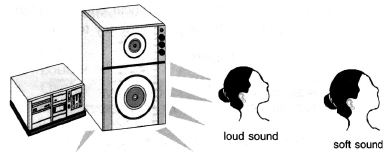
Loudness decreases with an increase in the distance between the ear and the source
4. Density of the medium
The loudness of sound is directly proportional to the density of the medium through which it propagates, i.e greater the density of the medium, louder is the sound.
Note: Loudness is more in dry air than in moist air which is lighter.
5. Presence of resonant bodies
The loudness of sound is increased due to the presence of other resonant bodies near the source of sound. For example, sound appears to be much louder inside a hall than in open air. It is because the walls, roof, floor, etc, reflect the sound. Consequently, the loudness is increased.
6. Motion of the medium
If wind is blowing in the direction of propagation of sound, loudness is increased. On the other hand, if wind is blowing in a direction opposite to the propagation of sound, loudness is decreased.
Measurement of Loudness of Sound:
The loudness of sound is measured in decibels (dB). The softest sound which human ears can hear is said to have a loudness of 0 dB (zero decibel). The loudness of sound of people talking quietly is about 65 dB, the loudness of sound in a very noisy factory is about 100 dB and the sound of a jet aircraft 50 metres away is said to have a loudness of about 130 dB.
Note:
1. Loudness increases with the amplitude of vibrating body.
2. Loudness increases with the increase in surface area of vibrating bodies.
3. Loudness decreases with the increase in distance from the source of sound.
Pitch or shrillness
Pitch is the characteristic of sound which enables us to distinguish a shrill sound from a dull sound.
1. A shrill sound has a high pitch and a dull sound has a low pitch. Women and children have shrill high pitched voices, whereas men havegrave law pitched voices.
2. All musical sound and notes have definite pitch. Pitch is the position of a note on a chosen musical scale.
3. We have sa, re, ga, ma, pa, dha, nee, in Indian music. ‘nee’ is higher than all the other notes.
Factor on which pitch of the sound depend
Pitch of a sound depends upon the frequency (or wavelength).
The sound produced by an object vibrating with a low frequency (or high wavelength, since frequency its pitch is low and the sound is described as grave or flat sound.
The sound produced by an object vibrating with a high frequency (or low wavelength), its pitch is high and the sound is described as shrill sound. Thus, higher the frequency of a musical sound, higher is its pitch and vice versa.
Note:
1. Greater the frequency of a sound the higher will be its pitch. A sound having a frequency 512Hz is higher pitch than a sound of frequency 256 Hz
2. Faster the vibration of the sound producing source, the higher is the frequency and higher is the pitch.
3. The voice of children and ladies is shrill as compared to the voice of men. This is because children and ladies have short vocal chords which therefore vibrate with a high frequencies to produce high pitched voice. Whereas men have long vocal chords which vibrate with a low frequency to produce low–pitched voice.
4. The wings of the bee and mosquito vibrate with a high frequency. Hence, the sound produced by them is shrill and high–pitched.
Quality or timbre
The quality of a sound is that property by virtue of which two sounds of the same pitch and loudness produced by two different musical instruments of people can be distinguished.
(OR)
Quality (or timbre) is that characteristic of musical sound which enables us to distinguish between the sounds of same pitch and loudness produced by different musical instruments (and different singers].
1. Two notes of the same pitch and loudness can sound different. The sound produced on a veena is different from the same pitched sound produced by a flute.
2. The difference in the quality of various tones is indicated by a difference in their wave forms.

Quality depend on waveforms
3. The sounds produced by different ‘singers’ such as S.P. Balasubrahmanyam, Udit Narayan, Lata Mangeshkar, Asha Bhonsle. Can be distinguished from one another on the basis of their quality or timbre.
4. We can even recognize a person from his voice (even without seeing him) on the basis of the unique quality or timbre of his voice.








